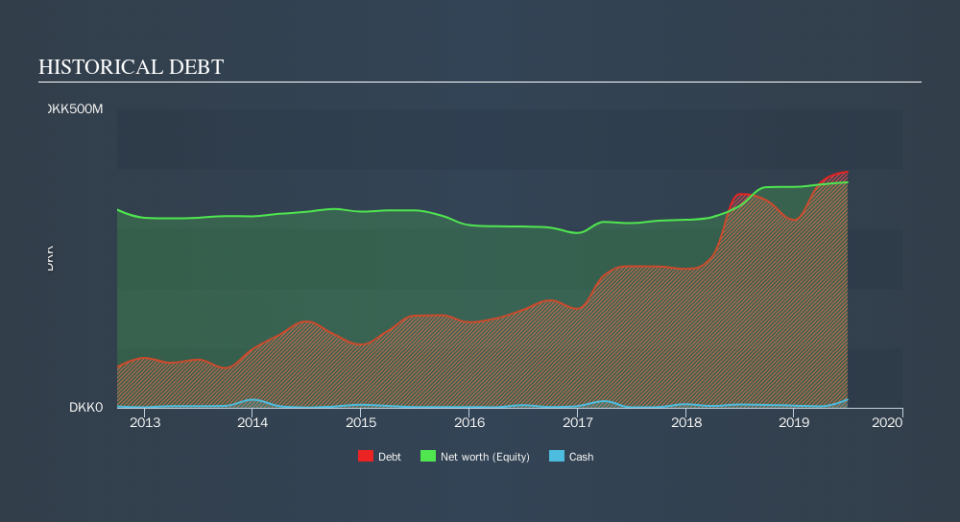Here's Why FirstFarms (CPH:FFARMS) Has A Meaningful Debt Burden

Legendary fund manager Li Lu (who Charlie Munger backed) once said, 'The biggest investment risk is not the volatility of prices, but whether you will suffer a permanent loss of capital. When we think about how risky a company is, we always like to look at its use of debt, since debt overload can lead to ruin. Importantly, FirstFarms A/S (CPH:FFARMS) does carry debt. But the more important question is: how much risk is that debt creating?
Why Does Debt Bring Risk?
Debt and other liabilities become risky for a business when it cannot easily fulfill those obligations, either with free cash flow or by raising capital at an attractive price. Part and parcel of capitalism is the process of 'creative destruction' where failed businesses are mercilessly liquidated by their bankers. However, a more common (but still painful) scenario is that it has to raise new equity capital at a low price, thus permanently diluting shareholders. Of course, debt can be an important tool in businesses, particularly capital heavy businesses. The first thing to do when considering how much debt a business uses is to look at its cash and debt together.
See our latest analysis for FirstFarms
How Much Debt Does FirstFarms Carry?
As you can see below, FirstFarms had ø369.0m of debt, at June 2019, which is about the same the year before. You can click the chart for greater detail. On the flip side, it has ø13.8m in cash leading to net debt of about ø355.2m.
How Healthy Is FirstFarms's Balance Sheet?
According to the last reported balance sheet, FirstFarms had liabilities of ø180.6m due within 12 months, and liabilities of ø305.5m due beyond 12 months. On the other hand, it had cash of ø13.8m and ø57.5m worth of receivables due within a year. So it has liabilities totalling ø414.8m more than its cash and near-term receivables, combined.
Given this deficit is actually higher than the company's market capitalization of ø409.6m, we think shareholders really should watch FirstFarms's debt levels, like a parent watching their child ride a bike for the first time. Hypothetically, extremely heavy dilution would be required if the company were forced to pay down its liabilities by raising capital at the current share price.
We use two main ratios to inform us about debt levels relative to earnings. The first is net debt divided by earnings before interest, tax, depreciation, and amortization (EBITDA), while the second is how many times its earnings before interest and tax (EBIT) covers its interest expense (or its interest cover, for short). This way, we consider both the absolute quantum of the debt, as well as the interest rates paid on it.
With net debt to EBITDA of 3.8 FirstFarms has a fairly noticeable amount of debt. On the plus side, its EBIT was 9.0 times its interest expense, and its net debt to EBITDA, was quite high, at 3.8. Pleasingly, FirstFarms is growing its EBIT faster than former Australian PM Bob Hawke downs a yard glass, boasting a 2817% gain in the last twelve months. When analysing debt levels, the balance sheet is the obvious place to start. But it is FirstFarms's earnings that will influence how the balance sheet holds up in the future. So when considering debt, it's definitely worth looking at the earnings trend. Click here for an interactive snapshot.
Finally, a business needs free cash flow to pay off debt; accounting profits just don't cut it. So it's worth checking how much of that EBIT is backed by free cash flow. During the last three years, FirstFarms burned a lot of cash. While that may be a result of expenditure for growth, it does make the debt far more risky.
Our View
Mulling over FirstFarms's attempt at converting EBIT to free cash flow, we're certainly not enthusiastic. But at least it's pretty decent at growing its EBIT; that's encouraging. Looking at the balance sheet and taking into account all these factors, we do believe that debt is making FirstFarms stock a bit risky. Some people like that sort of risk, but we're mindful of the potential pitfalls, so we'd probably prefer it carry less debt. Over time, share prices tend to follow earnings per share, so if you're interested in FirstFarms, you may well want to click here to check an interactive graph of its earnings per share history.
If, after all that, you're more interested in a fast growing company with a rock-solid balance sheet, then check out our list of net cash growth stocks without delay.
We aim to bring you long-term focused research analysis driven by fundamental data. Note that our analysis may not factor in the latest price-sensitive company announcements or qualitative material.
If you spot an error that warrants correction, please contact the editor at editorial-team@simplywallst.com. This article by Simply Wall St is general in nature. It does not constitute a recommendation to buy or sell any stock, and does not take account of your objectives, or your financial situation. Simply Wall St has no position in the stocks mentioned. Thank you for reading.


